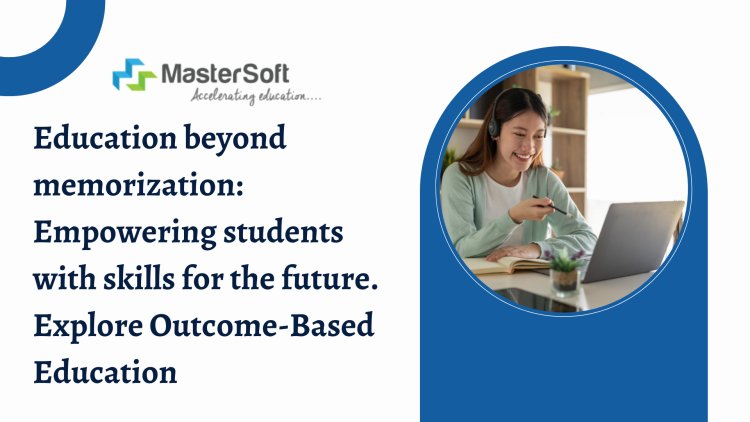Empowering Learners with Outcome-Based Education
Unleash the power of Outcome-Based Education (OBE)! Discover how OBE transforms classrooms, empowers learners, and fosters essential 21st-century skills.
Share this Post to earn Money ( Upto ₹100 per 1000 Views )

The traditional education system, often focused on memorization and standardized tests, is undergoing a significant transformation. Outcome-Based Education (OBE) emerges as a powerful approach that prioritizes student learning and achievement of specific skills and knowledge. Imagine a classroom where students actively participate in activities that directly connect to their learning goals. This is the essence of OBE, and its potential to empower learners and propel them towards success in a dynamic world is undeniable. Let's delve into the world of OBE, exploring its core principles and how it can transform the learning experience.
Shifting the Focus: From Content Delivery to Measurable Outcomes
Traditional education often resembles a one-way street – teachers deliver information, and students are expected to absorb it. OBE flips this script. At its heart lies a fundamental shift in focus. Instead of solely emphasizing curriculum content and standardized tests, OBE prioritizes the specific skills and knowledge students will gain by the end of a course or program. These "outcomes" are clearly defined and measurable, ensuring a clear direction for both educators and learners.
With a focus on measurable outcomes, educators can design engaging and interactive learning experiences that equip students with the necessary skills to achieve them. Imagine a classroom environment where students actively participate in projects, discussions, and problem-solving activities, all directly linked to the defined learning goals.
Redesigning the Classroom Experience: Active Learning Takes Center Stage
Traditional classrooms often paint a picture of passive learning – students passively absorbing information delivered through lectures and textbooks. OBE flips the script on this approach too. Educators design engaging and interactive learning experiences that equip students with the necessary skills to achieve the predefined outcomes. This may involve hands-on projects, collaborative activities, problem-solving exercises, and real-world simulations, all carefully curated to bridge the gap between theory and practical application.
Redefining Assessment: Moving Beyond Grades
Traditional assessments often focused on a single test score. OBE takes a more holistic approach. Evaluations become an ongoing process, incorporating a variety of assessment methods. These may include presentations, portfolios, quizzes, self-reflection exercises, and peer assessments. The focus shifts from simply measuring content knowledge to evaluating whether students can apply their learning to solve problems, think critically, and demonstrate essential skills.
A Symphony of Benefits: Why Embrace Outcome-Based Education?
OBE offers a plethora of benefits for both students and educators:
- Enhanced Student Engagement: Clearly defined outcomes and engaging learning experiences spark student interest and motivation. Students actively participate in their learning journey, understanding the "why" behind what they are learning.
- Personalized Learning: OBE allows for a more personalized learning approach. Educators can identify areas where individual students need additional support and tailor instruction to address those needs.
- Developed Critical Thinking and Problem-Solving Skills: The emphasis on application and real-world scenarios within OBE fosters the development of critical thinking and problem-solving skills, which are crucial for success in the 21st century.
- Data-Driven Decision Making: Ongoing assessments within OBE provide valuable data on student progress. Educators can use this data to identify areas needing improvement in the curriculum or teaching strategies, fostering continuous improvement.
Transparency and Accountability: Building Trust in the Process
Clearly defined learning outcomes create transparency for students and stakeholders. They understand the expected learning goals and can track their progress towards achieving them. This transparency fosters trust in the educational process and motivates students to take ownership of their learning.
Lifelong Learning: Equipping Students for the Future
OBE encourages students to become self-directed learners. The focus on applying knowledge and developing essential skills prepares students for lifelong learning and adapting to a rapidly changing world. Students are empowered to take initiative, solve problems independently, and continuously seek out new knowledge and skills throughout their lives.
Implementation: Charting a Course for Success
Transitioning to OBE requires careful planning and implementation. Here are some key steps:
- Define Program and Course Outcomes: Clearly define the desired learning outcomes for your program or course. These outcomes should be measurable and relevant to the skills students need.
- Develop a Curriculum Alignment Strategy: Ensure the curriculum and learning activities align with the defined outcomes.
- Select Appropriate Assessment Methods: Choose a variety of assessment tools that effectively measure student achievement of the outcomes.
- Provide Ongoing Feedback and Support: Students need consistent feedback to track their progress and identify areas for improvement.
- Continuous Improvement: Regularly review data, analyze student performance, and make adjustments to the learning process as needed.
Conclusion: A Brighter Future for Learning
Outcome-based education presents a compelling vision for the future of learning. It fosters a student-centered environment where students are actively engaged and empowered to achieve.







